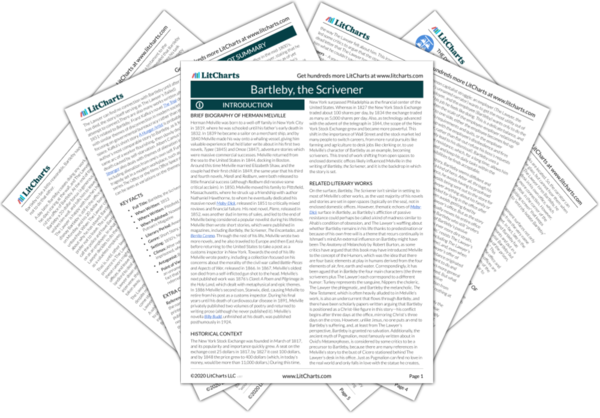Bartleby, the Scrivener is set during a time when Wall Street was becoming ever more important as a financial hub of American society, a society that was itself being transformed by the increasing importance of capital and finance in an industrializing world. This transformation had many impacts, but one of them was the increasing prevalence of the sort of office workplace in which the story is set. In fact, if you want to push things a bit, you could argue that Bartleby is one of the first office comedies, though Bartleby’s “comedy” and viewpoint is so dark that it actually ends up as an office tragedy. Regardless, the tropes about the office that have come to dominate office comedies such as The Office or Office Space – the dreary dullness, absurdity, and disconnection of the office workplace – are captured with unmatched power in Bartleby.
Disconnection, in fact, is the basic state of this Wall Street law office. Turkey and Nippers, the two scriveners who work for The Lawyer before he brings on Bartleby, initially seem like comic characters (because they are described in comic ways by The Lawyer/Narrator who employs them). But the story manages to communicate deep despair in their situations and character that the narrator himself fails to understand. The description of these two clerks working like “sentries” who trade guard, as one is productive only in the morning and the other only in the afternoon, establishes their separateness. They work in the same place, but are never in any way together. Further, some close reading reveals what the narrator himself seems not to see: that Turkey is only a good employee before noon because he gets drunk at lunch, while a number of critics suggest that Nippers’s “indigestion” that afflicts him in the morning is likely the result of a drug addiction that The Lawyer is oblivious to.
The sense of disconnection between the people in the office is heightened by The Lawyer’s many failed efforts to get to know Bartleby (his only employee that he refers to by name). In fact, the entire time The Lawyer knows Bartleby, from when he hires him until Bartleby’s imprisonment, The Lawyer learns nothing more from Bartleby about his history or personality than his name. Even when, at the story’s very end, The Lawyer finally includes details about Bartleby’s past (that he worked at the Dead Letter Office), he states that he has learned this through rumor only, so even this alleged information is disconnected from certainty.
Melville further builds the dreary disconnection of the office through its physical setting and space. One of the story’s recurring symbols is the suffocating presence of walls within the law office. The narrator notes early on that the few windows in the office produce little to no light, as they run up against the walls of adjacent buildings, though that doesn’t stop Bartleby from staring out them for hours at a time. Also, the office itself is divided by “ground-glass folding doors” into two separate rooms, one in which The Lawyer works, and one where the scriveners’ desks are located. So, the narrator can see his workers through the glass, but cannot hear them when the doors are closed. When The Lawyer hires Bartleby, he decides to station Bartleby’s desk in his own office, which would hint at the possibility for more connection. However, even then, The Lawyer places the desk in the corner of the room and provides a “high green folding screen” that keeps Bartleby within earshot but serves to “entirely isolate Bartleby” from his sight.
This feeling of disconnection and entrapment surfaces not only from the office’s cramped layout, but also from the very name of the street where it is located: Wall Street. In fact, late in the story, after The Lawyer has moved offices and Bartleby has been forcibly removed by its subsequent tenants and put in a prison called The Tombs, the Lawyer goes to visit Bartleby but ends up getting trapped in the central yard area of the prison, with its “surrounding walls of amazing thickness.” This description, mirroring the earlier description of the office and the very name of the street on which so many such offices are located, perhaps implies that in the Wall Street boom of the mid-1800’s, offices in general had become eerily similar to prison cells.
The Disconnected Workplace ThemeTracker

The Disconnected Workplace Quotes in Bartleby, the Scrivener
To befriend Bartleby; to humor him in his strange willfulness, will cost me little or nothing, while I lay up in my soul what will eventually prove a sweet morsel for my conscience. But this mood was not invariable with me. The passiveness of Bartleby sometimes irritated me. I felt strangely goaded on to encounter him in new opposition… I might as well have essayed to strike fire with my knuckles against a bit of Windsor soap.
… Ah, happiness courts the light, so we deem the world is gay, but misery hides aloof, so we deem that misery there is none.
“At present, I would prefer not to be a little reasonable,” was his mildly cadaverous reply.
“…Good-bye, Bartleby, and fare you well.” But he answered not a word; like the last column of some ruined temple, he remained standing mute and solitary in the middle of the otherwise deserted room.
It was the circumstance of being alone in a solitary office, up stairs, of a building entirely unhallowed by humanizing domestic associations…which greatly helped to enhance the irritable desperation of the hapless Colt.
















